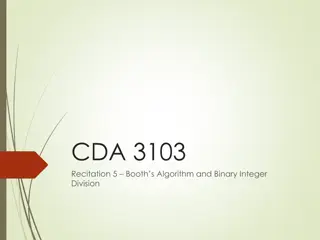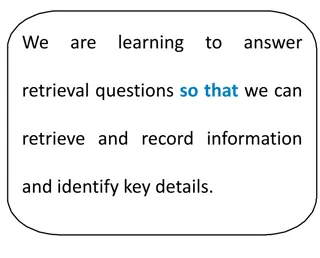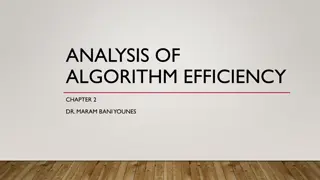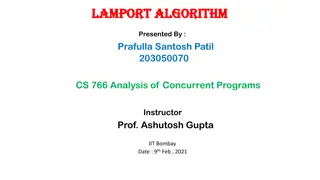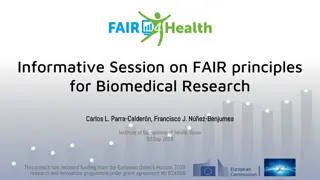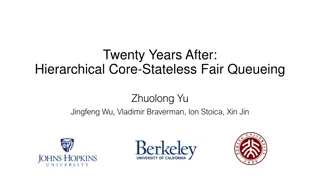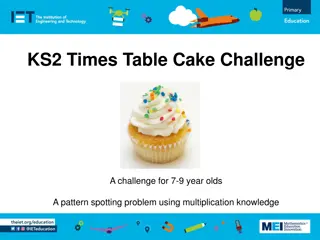Desirable Fair Cake-Cutting Algorithm in Practice
This content discusses the concept of a desirable fair cake-cutting algorithm in practice, detailing the cake-cutting problem, assumptions, equitability, ratio-based allocation, and Pareto optimality. It explores cases where every ratio-based allocation is Pareto optimal, providing insights into maximizing social welfare in cake division scenarios.
Download Presentation

Please find below an Image/Link to download the presentation.
The content on the website is provided AS IS for your information and personal use only. It may not be sold, licensed, or shared on other websites without obtaining consent from the author.If you encounter any issues during the download, it is possible that the publisher has removed the file from their server.
You are allowed to download the files provided on this website for personal or commercial use, subject to the condition that they are used lawfully. All files are the property of their respective owners.
The content on the website is provided AS IS for your information and personal use only. It may not be sold, licensed, or shared on other websites without obtaining consent from the author.
E N D
Presentation Transcript
Cake-cutting Problem cake: [0, 1] agents: N = {1, , n} allocation: A = {A1, , An} valuation function of agent i: vi(I), I is union of subintervals in [0,1] social welfare: ??(??)
Assumptions additive valuation functions: vi(I)+vi(I ) = vi(I I ) vi(I)>=0 normalize: vi([0, 1]) = 1, for every agent I non-atomic: vi([x, x]) = 0
Equitability (EQ) interpersonal comparisons of utility among agents EQ allocation: A s.t. vi(Ai) = vj(Aj), for all i, j
2 Agents An interval I is strictly/weakly desired by agent 1 if v1(I) >(=) v2(I) Claim: for 2 agents, every maxsum EQ allocation (largest possible social welfare that EQ allocations can get) is Pareto Optimal (PO)
Ratio-based Allocation Y1 op 2= {x: v1(x) op v2(x)} e.g. Y1 > 2represents all intervals that are strictly desired by agent 1 Ratio of valuation functions: R1(x) = v1(x) / v2(x)
Ratio-based Allocation YR1 = 0.5 YR1 > 0.5 Y1 > 2 v agent 2 agent 1 R1(x)=0.5 x R1(x) =1 R1(x) =1 Reference: "On maxsum fair cake divisions."
Ratio-based Allocation Reference: "On maxsum fair cake divisions."
Every Ratio-based Allocation is PO Case 1: r* = 1 All intervals are allocated to the agent who weakly desires the interval
Every Ratio-based Allocation is PO Case 2: r* < 1 Without loss of generality, let agent 1 receive all her weakly desired intervals (red) plus some of agent 2 s strictly desired intervals (yellow) v1(A1) >= v1(Y1 >= 2) YR1 = r* YR1 > r* Y1 > 2 v agent 2 agent 1 R1(x)=r* x R1(x) =1 R1(x) =1
Every Ratio-based Allocation is PO Reference: "On maxsum fair cake divisions."
Every Maxsum EQ Allocation is PO Case 1: v1(Y1 >= 2) >= v2(Y2 > 1) and v2(Y2 >= 1) >= v1(Y1 > 2) Allocate Y1 > 2 to agent 1, Y2 > 1 to agent 2; split Y1 = 2 to satisfy EQ Always feasible Maxsum allocation implies PO Y1 = 2 Y1 > 2 Y2 > 1 v agent 2 agent 1 x R1(x) =1 R1(x) =1
Every Maxsum EQ Allocation is PO Case 2: without loss of generality, v1(Y1 >= 2) < v2(Y2 > 1) Consider R1(x) from 1 to 0: v1: from v1(Y1 >= 2) to 1 v2: from v2(Y2 > 1) to 0 There exists a ratio-based allocation that is maxsum EQ v 1 agent 1 agent 2 R1(x) 0 r*
Every Maxsum EQ Allocation is PO Case 2: without loss of generality, v1(Y1 >= 2) < v2(Y2 > 1) Since every ratio-based allocation is PO, maxsum PO allocation is not Pareto-dominated by any other allocation ; thus, it is PO
More theorems For 2 agents, maxsum EF and EF+EQ allocations are also PO For 3 or more agents, both maxsum EF and EQ allocations may not be PO For piecewise linear valuation functions, the max social welfare of EF allocations >= that of EQ allocations
Fair-cake Cutting Protocols Robertson-Webb Model: 2 Types of queries (to avoid trivial protocols): Cut(p, a): player p returns x s.t. v([0, x]) = a, v([x, 1]) = 1-a Eval(p, x): player p returns a = v([0, x]) Assign operation: assign disjoint interval (x, y) to player p Complexity is measured by the number of cuts in the worst case
Knaster Banach Last Diminisher Protocol For n agents, given a cake [y, 1], agent 1 chooses a cut x1 so that v1(y, x1) = v1(y, 1)/n. Agent 2 now has the right, but is not obliged, to choose x2 < x1. Whatever she does, agent 3 has the right, without obligation, to further diminish the already diminished (or not diminished) piece too, and so on up to n. The rule obliges the last diminisher (say agent i) who chose the cut xi to take as her allocation Ai = [y, xi). Agent i is disposed of, and the remaining n 1 persons start the same game with the remainder of the cake [xi, 1]. When there is only one agent left, she receives the unclaimed piece of cake. O(n2) agent 1 agent 3 remaining cake
Even-Paz Algorithm For n agents, given a cake [y, z], all agents choose cuts xi such that vi(y, xi) = vi(y,z)/2. We let x be the median cut, i.e. the n/2 th cut. Then the procedure breaks the cake-cutting problem into two: all agents who choose cuts xi x are to divide the cake [y, x ), whereas all agents who chose cuts above x are to divide the cake [x , z]. Each half is divided recursively among the n/2 partners assigned to it. When the procedure is called with a singleton set of agents {i} and an interval I it assigns Ai = I. O(nlog(n)) medium cut agent 2 agent 1 agent 4 agent 3 remaining cake
"On the complexity of cake cutting. provides a lower bound of O(nlog(n)) on a restricted version of Robertson-Webb Model (assign only once for each agent; count number of queries+cuts) "Fair cake-cutting in practice. gives examples to demonstrate that most well-known protocols are not strategy-proof. In fact, an agent can get a max social welfare of 1 if she knows other agents valuation functions.
References 1. Brams, Steven J., Michal Feldman, John K. Lai, Jamie Morgenstern, and Ariel D. Procaccia. "On maxsum fair cake divisions." In Twenty- sixth AAAI Conference on Artificial Intelligence. 2012. 2. Woeginger, Gerhard J., and Ji Sgall. "On the complexity of cake cutting." Discrete Optimization 4, no. 2 (2007): 213-220. 3. Kyropoulou, Maria, Josu Ortega, and Erel Segal-Halevi. "Fair cake- cutting in practice." In Proceedings of the 2019 ACM conference on economics and computation, pp. 547-548. 2019.




